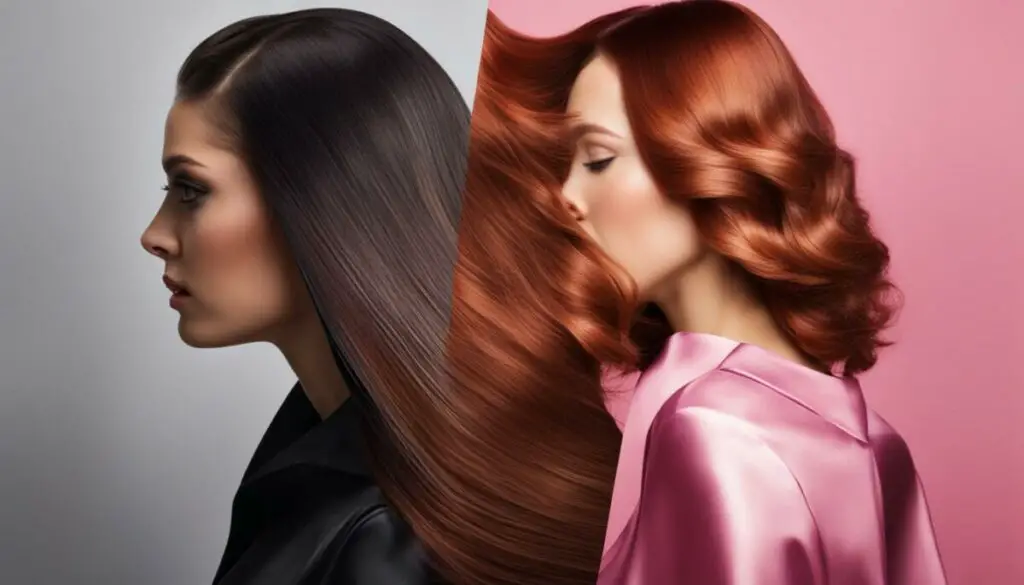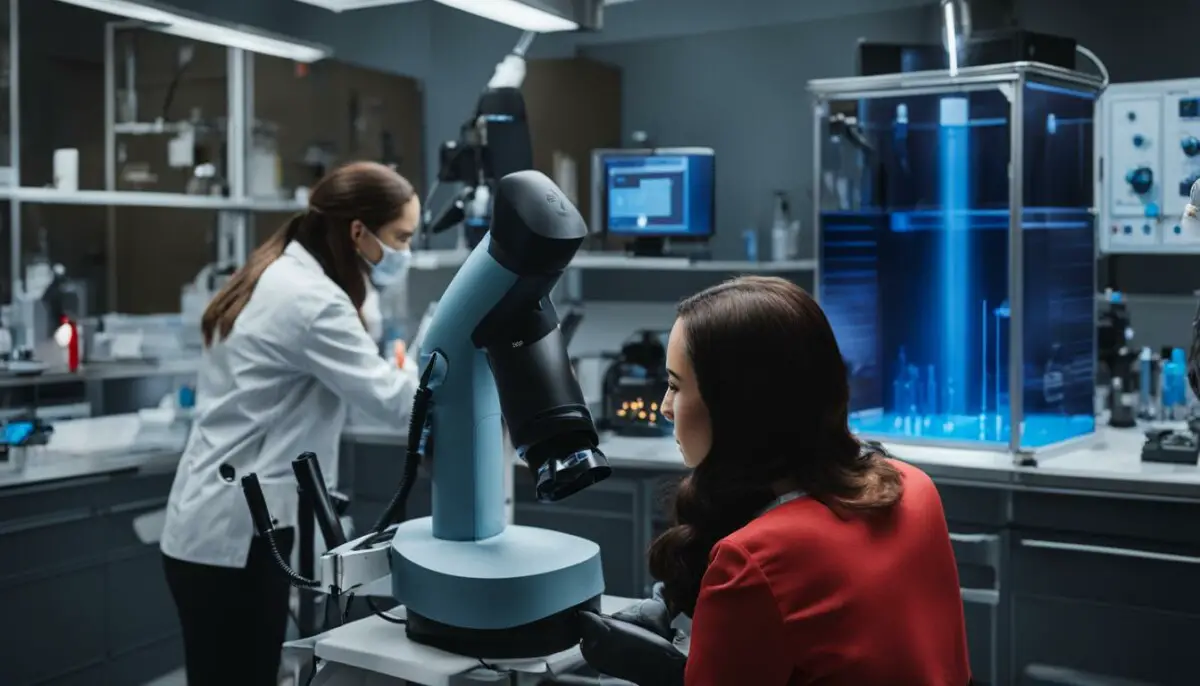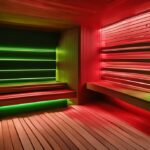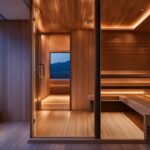Last Updated on 5 months by Francis
Welcome to our comprehensive guide on the safety of infrared hair dryers! In recent years, these innovative hair styling tools have gained popularity for their ability to provide faster and healthier drying results. But as with any new technology, questions about their safety have emerged. In this article, we will delve into the topic and address concerns surrounding infrared hair dryers, hair dryer safety, safe styling techniques, and how to choose a safe hair dryer.
Contents
Key Takeaways:
- Despite concerns about electromagnetic field (EMF) exposure, infrared hair dryers emit low-frequency EMFs that are not considered dangerous to human health.
- Infrared heat technology in hair dryers offers advantages such as faster drying times, reduced damage to hair, and improved hair health.
- Infrared heat differs from traditional heat sources by penetrating the hair shaft more effectively, operating at lower temperatures, and targeting water molecules within the hair.
- Overheating protection is crucial in hair dryers as it automatically shuts off the device when reaching a specific temperature, preventing fire hazards and protecting user safety.
- Overheating in hair dryers can lead to moisture loss, dry and brittle hair, frizz, split ends, and breakage, emphasizing the importance of utilizing hair dryers with overheating protection.
The Advantages of Infrared Heat in Hair Dryers
Infrared heat in hair dryers offers several advantages over traditional heat sources. It penetrates the hair shaft more effectively, ensuring moisture is retained within the strands. This results in faster drying times and reduces the risk of excessive heat damage. Infrared heat also promotes shine and smoothness, as well as improved overall hair health. The technology used in infrared hair dryers harnesses the power of infrared heat to provide enhanced hair care and drying experiences.
One of the key benefits of infrared hair dryers is their ability to penetrate the hair shaft more deeply compared to traditional heat sources. This allows the heat to reach the inner layers of the hair, drying it more efficiently from the inside out. As a result, the hair is exposed to heat for a shorter duration, reducing the risk of damage from prolonged exposure.
Additionally, infrared heat helps to seal the hair cuticles, locking in moisture and reducing frizz. This can result in smoother, shinier hair that is less prone to flyaways. The gentle yet effective drying provided by infrared heat technology promotes overall hair health by minimizing damage and maintaining the hair’s natural moisture balance.
| Advantages of Infrared Heat in Hair Dryers |
|---|
| Penetrates the hair shaft more effectively |
| Retains moisture within the strands |
| Reduces drying time |
| Promotes shine and smoothness |
| Enhances overall hair health |
The advantages of infrared heat in hair dryers make them a popular choice for individuals looking to achieve efficient and healthy hair drying. By harnessing the power of infrared technology, these hair dryers provide superior drying results while minimizing damage to the hair. Whether you’re seeking faster drying times, smoother hair, or enhanced overall hair health, an infrared hair dryer can be a beneficial addition to your hair care routine.
Understanding Infrared Heat and Its Differences from Traditional Heat

Infrared heat technology is a key component of modern hair dryer technology. It operates at a lower temperature than traditional heat sources and has the ability to penetrate the hair shaft more effectively. Unlike traditional heat, which primarily dries the surface of the hair, infrared heat directly targets the water molecules within the hair, reducing drying time and minimizing heat damage.
The use of infrared heat in hair dryers offers several advantages over traditional heat sources. It not only speeds up the drying process but also helps to retain moisture within the hair strands. This results in healthier, shinier, and smoother-looking hair. Additionally, the lower temperature of infrared heat reduces the risk of heat-related damage, such as frizz, split ends, and breakage.
While concerns about potential risks of infrared hair dryers exist, it is important to note that they are designed to emit low-frequency electromagnetic fields (EMFs). These EMFs are considered safe for regular use and do not pose significant health risks. However, it is always recommended to use hair dryers responsibly and follow manufacturer’s instructions to ensure the safest and most effective use of the device.
Table: Comparing Infrared Heat and Traditional Heat
| Infrared Heat | Traditional Heat |
|---|---|
| Penetrates the hair shaft more effectively | Mainly dries the surface of the hair |
| Operates at a lower temperature | Operates at a higher temperature |
| Targets water molecules within the hair | Generates heat on the hair surface |
| Reduces drying time | May take longer to dry hair |
| Helps retain moisture | May result in drier hair |
| Reduces the risk of heat-related damage | May cause frizz, split ends, and breakage |
By understanding the differences between infrared heat and traditional heat, consumers can make informed choices when selecting a hair dryer that best suits their needs and hair type.
Overheating Protection: Ensuring Safety in Hair Dryers
When it comes to the safety of hair dryers, one crucial feature that should not be overlooked is overheating protection. This feature is designed to automatically shut off the hair dryer when it reaches a specific temperature, preventing potential fire hazards and protecting both the user and their surroundings. Understanding the importance of safety features in hair dryers, such as overheating protection, allows consumers to prioritize their well-being while using these appliances.
Overheating protection plays a vital role in enhancing user safety during hair drying sessions. By preventing excessive heat buildup, it minimizes the risk of heat-induced damage to both the hair and the hair dryer itself. This feature ensures that the hair dryer operates within safe temperature limits, delivering efficient drying results without compromising safety. Manufacturers place great emphasis on incorporating overheating protection mechanisms in their hair dryer designs to safeguard user well-being.
Having a hair dryer with overheating protection provides users with peace of mind, knowing that they can enjoy the benefits of a hair dryer without the worry of overheating. By investing in a hair dryer equipped with this essential safety feature, individuals can confidently style their hair and dry it efficiently, all while minimizing the risk of potential accidents or damage.
| Benefits of Overheating Protection | Importance of Understanding Safety Features | |
|---|---|---|
| Enhances user safety | Allows for worry-free hair drying | Prevents potential accidents or damage |
| Protects the hair and the hair dryer | Delivers efficient drying results | Prioritizes user well-being |
In conclusion, the inclusion of overheating protection in hair dryers is crucial for ensuring both the safety of users and the longevity of the hair dryer itself. This essential safety feature prevents excessive heat buildup and potential damage, allowing individuals to enjoy efficient hair drying without compromising their well-being. Understanding the benefits of overheating protection and its importance in hair dryers empowers consumers to make informed decisions when choosing a safe and reliable hair dryer.
The Impact of Overheating on Hair Health
Overheating in hair dryers can have detrimental effects on hair health. Excessive heat exposure can lead to moisture loss, causing the hair to become dry and brittle. It can also damage the hair shaft, resulting in frizz, split ends, and breakage. The potential risks of overheating on hair should not be overlooked, as they can significantly affect the overall condition of your locks.
When the hair is subjected to high temperatures for extended periods of time, the natural oils and moisture within the hair strands are stripped away, leaving the hair vulnerable and prone to damage. Overheating can compromise the structural integrity of the hair, making it weaker and more susceptible to breakage. The excessive heat can also cause the cuticles, the protective outer layer of the hair, to lift and become damaged, resulting in a rough and frizzy appearance.
It is important to be mindful of the potential risks associated with overheating and take necessary precautions to protect your hair. Using hair dryers with overheating protection is essential to prevent excessive heat exposure. These safety features automatically shut off the device or reduce the heat output when the internal temperature exceeds a certain threshold, minimizing the risk of heat-induced damage. Additionally, using heat-protectant products before styling can provide an extra layer of protection against the damaging effects of overheating.
| Potential Risks of Overheating on Hair Health | Effects on Hair |
|---|---|
| Moisture Loss | Leads to dry and brittle hair |
| Hair Shaft Damage | Causes frizz, split ends, and breakage |
| Weakening | Compromises the structural integrity of the hair |
| Heat-Induced Cuticle Damage | Results in rough and frizzy hair |
By understanding the potential risks of overheating and taking appropriate measures to prevent them, you can maintain the health and vitality of your hair. It is crucial to prioritize the well-being of your hair and make informed choices when using heat styling tools like hair dryers.
The Role of Overheating Protection in Hair Dryers

Incorporating overheating protection in hair dryers is essential for ensuring user safety and preventing potential accidents or harm. Overheating protection is a safety feature that automatically shuts off the device or reduces its heat output when the internal temperature exceeds a certain threshold. This feature is crucial in preventing excessive heat exposure to the hair, minimizing the risk of heat-induced damage.
One of the benefits of overheating protection is its ability to prevent potential fire hazards. When a hair dryer reaches a specific temperature, the overheating protection feature ensures that the device automatically shuts off, protecting the user and their surroundings from the risk of fire. By prioritizing safety features like overheating protection, users can use their hair dryers with peace of mind, knowing that they are protected from potential hazards.
Having safety features in hair dryers, such as overheating protection, is important regardless of the price point. Whether it’s a high-end professional hair dryer or an affordable consumer-grade option, the availability of overheating protection ensures user safety. By understanding the role of overheating protection, individuals can make informed decisions when purchasing hair dryers and prioritize their well-being.
The Benefits of Overheating Protection in Hair Dryers
- Prevents excessive heat exposure to the hair
- Minimizes the risk of heat-induced damage
- Protects against potential fire hazards
- Enhances user safety and peace of mind
Comparison of Hair Dryers with and without Overheating Protection
| Hair Dryers without Overheating Protection | Hair Dryers with Overheating Protection | |
|---|---|---|
| Heat exposure | May expose hair to excessive heat, leading to damage | Minimizes heat exposure, reducing the risk of damage |
| Safety | May pose a higher risk of fire hazards | Automatically shuts off to prevent fire hazards |
| User experience | May cause anxiety and concern about overheating | Provides peace of mind and confidence in safety |
“Incorporating overheating protection in hair dryers not only prevents excessive heat exposure and potential damage to the hair but also ensures user safety and peace of mind.”
Debunking Safety Concerns: EMF Emissions from Hair Dryers
One common safety concern regarding infrared hair dryers is the potential electromagnetic field (EMF) emissions they may produce. However, it’s important to understand that the EMFs emitted by hair dryers are generally low-frequency and are considered safe for human exposure. Hair dryers, including those with infrared heat technology, emit low levels of radiation that do not harm molecules in the human body.
For individuals who are sensitive to EMFs or have specific concerns, there are low EMF hair dryers available. These hair dryers are designed to minimize EMF emissions even further, providing peace of mind for those who prioritize minimizing exposure to electromagnetic fields.
“Hair dryers emit low-frequency electromagnetic fields, which are not considered harmful to human health. However, for individuals who are particularly sensitive to EMFs, low EMF hair dryers can provide an additional level of reassurance.” – Hair Care Expert
It’s important to note that the safety of infrared hair dryers goes beyond EMF emissions. Manufacturers prioritize overall safety by incorporating features such as overheating protection, which automatically shuts off the device if it reaches a certain temperature. This feature not only prevents potential fire hazards but also protects the user and their surroundings from excessive heat exposure.
| Concerns | Reality |
|---|---|
| EMF Emissions | Low-frequency EMFs emitted by hair dryers are safe for human exposure. Low EMF hair dryers are available for individuals with specific concerns. |
| Overheating | Hair dryers are equipped with overheating protection to ensure user safety and prevent potential heat-induced damage. |
By understanding the facts and debunking safety concerns, individuals can feel confident in using infrared hair dryers without compromising their well-being. It’s essential to choose a hair dryer that meets personal needs and preferences while also incorporating necessary safety features.
The Pros and Cons of Infrared Hair Dryers

Infrared hair dryers offer numerous benefits, but they also have some drawbacks that consumers should consider before making a purchase. Here’s a look at the pros and cons of using infrared hair dryers:
Benefits of Infrared Hair Dryers
- Faster Drying Times: Infrared heat technology allows for more efficient drying, reducing the overall drying time compared to traditional hair dryers.
- Reduced Damage to Hair: The gentle infrared heat penetrates the hair shaft more effectively, minimizing heat damage and preserving the hair’s moisture and health.
- Improved Hair Health: Infrared heat promotes shine, smoothness, and overall hair health by retaining moisture and reducing frizz and breakage.
Drawbacks of Infrared Hair Dryers
- Higher Cost: Infrared hair dryers tend to be more expensive than traditional hair dryers due to the advanced technology used.
- Bulky and Heavy Designs: Some infrared hair dryers may be bulkier and heavier than their traditional counterparts, making them less convenient for travel or long styling sessions.
- Additional Features can be Confusing: Infrared hair dryers often come with various settings and features, which may be overwhelming for users who prefer a simple and straightforward drying experience.
Overall, infrared hair dryers offer significant advantages in terms of efficiency and hair health. However, the higher cost and potentially bulkier designs may not be suitable for everyone. It’s important for consumers to weigh the benefits against the drawbacks and make an informed decision based on their individual needs and preferences.
| Pros | Cons |
|---|---|
| Faster drying times | Higher cost |
| Reduced damage to hair | Bulky and heavy designs |
| Improved hair health | Additional features can be confusing |
The Safety of Infrared Heat on Hair
When it comes to the safety of infrared hair dryers, it’s important to understand the potential risks of infrared heat and its effects on hair. Infrared heat is generally considered safe for hair and can even offer benefits such as improved blood flow to the scalp and moisture retention. However, responsible usage is crucial to prevent any potential damage from excessive heat exposure.
One of the main concerns with infrared heat is the potential to overheat the hair. While infrared heat is gentler on the hair compared to many other forms of heat styling, prolonged exposure to high temperatures can still cause damage. It’s important to use heat-protectant products and avoid exposing the hair to excessive heat to maintain its health.
Understanding the safety of infrared heat on hair helps individuals make informed decisions when using infrared hair dryers. By following proper usage guidelines and taking precautions to protect the hair, individuals can enjoy the benefits of infrared heat technology without compromising their hair health.
Risks of Infrared Heat on Hair
While infrared heat is generally safe for hair, there are some potential risks to be aware of. Excessive heat exposure can lead to moisture loss, causing the hair to become dry and brittle. It can also damage the hair shaft, resulting in frizz, split ends, and breakage. To mitigate these risks, it’s crucial to use infrared hair dryers responsibly and avoid prolonged and excessive heat exposure.
| Risk | Effect on Hair |
|---|---|
| Moisture Loss | Dry and brittle hair |
| Hair Shaft Damage | Frizz, split ends, and breakage |
To maintain hair health while using infrared hair dryers, it’s recommended to follow these guidelines:
- Use a heat-protectant product before drying or styling your hair.
- Avoid using the highest heat setting on the hair dryer.
- Keep the dryer a safe distance from your hair, typically 6 to 8 inches away.
- Move the dryer continuously to prevent concentrated heat in one area.
- Avoid drying the hair for extended periods; take breaks if needed.
By following these precautions, individuals can safely enjoy the benefits of infrared hair dryers while minimizing the potential risks associated with infrared heat.
Conclusion
After exploring the safety and benefits of infrared hair dryers, it is clear that they are a safe option for hair drying. The use of infrared heat technology in these dryers provides faster and gentler drying results, reducing damage to the hair. With low-frequency electromagnetic field (EMF) emissions, infrared hair dryers do not pose significant health risks.
When choosing a safe hair dryer, it is important to consider the availability of safety features such as overheating protection. These features ensure that the device automatically shuts off when it reaches a specific temperature, preventing potential fire hazards and protecting both the user and their surroundings.
Overall, infrared hair dryers offer several advantages, including reduced drying time, improved hair health, and enhanced styling results. While they may have some drawbacks such as higher costs and bulkier designs, the benefits outweigh these drawbacks for many individuals. By understanding the safety aspects and benefits of infrared hair dryers, consumers can make informed choices and select a hair dryer that suits their needs.
FAQ
Are infrared hair dryers safe to use?
Yes, infrared hair dryers are generally safe for regular use. They utilize infrared heat technology, which is gentle on the hair and helps retain moisture, reduce frizz, and promote overall hair health.
Do infrared hair dryers emit harmful electromagnetic fields (EMFs)?
No, infrared hair dryers emit low-frequency EMFs that are not considered dangerous to human health. The EMFs emitted by hair dryers are generally safe and do not pose significant risks.
What are the advantages of infrared heat in hair dryers?
Infrared heat penetrates the hair shaft more effectively, resulting in faster drying times and reduced damage to the hair. It also promotes shine, smoothness, and improved overall hair health.
How does overheating protection ensure safety in hair dryers?
Overheating protection is a safety feature that automatically shuts off the hair dryer when it reaches a specific temperature. This prevents potential fire hazards, protects the user and their surroundings, and minimizes the risk of heat-induced damage to the hair.
What are the potential risks of overheating on hair health?
Overheating in hair dryers can lead to moisture loss, dry and brittle hair, frizz, split ends, and breakage. It is important to utilize hair dryers with overheating protection to prevent these issues and maintain hair health.
What is the role of overheating protection in hair dryers?
Overheating protection ensures user safety by preventing excessive heat buildup. It automatically shuts off the hair dryer or reduces its heat output when the internal temperature exceeds a certain threshold, protecting the hair and the hair dryer from potential damage.
Do hair dryers emit harmful electromagnetic fields (EMFs)?
Hair dryers emit low-frequency EMFs that are generally safe for human exposure. They do not harm molecules in the human body. However, for individuals sensitive to EMFs or with specific concerns, low EMF hair dryers are available to minimize EMF emissions even further.
What are the pros and cons of infrared hair dryers?
Infrared hair dryers offer benefits such as faster drying times, reduced damage to hair, and improved hair health. However, they can be more expensive than traditional hair dryers and may be bulkier or heavier. Some users may find the additional features and settings confusing.
Is infrared heat safe for hair?
Yes, infrared heat is generally safe for hair. It is gentler on the hair compared to many other forms of heat styling. However, responsible usage is crucial to prevent any potential damage from excessive heat exposure. It’s important to use heat-protectant products and avoid exposing the hair to excessive heat.
Are infrared hair dryers a safe choice?
Yes, infrared hair dryers are generally safe to use. They offer benefits such as faster drying times and reduced damage to hair. By understanding the safety aspects and benefits of infrared hair dryers, individuals can make informed choices when selecting a safe and efficient hair dryer.








